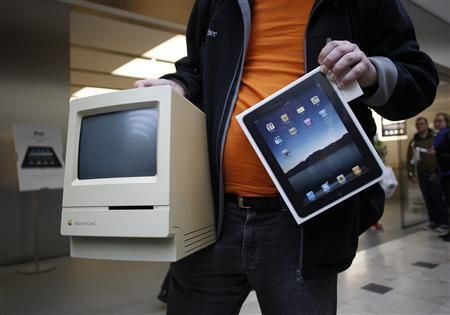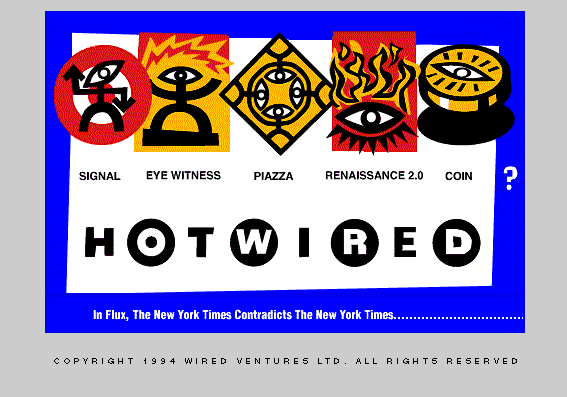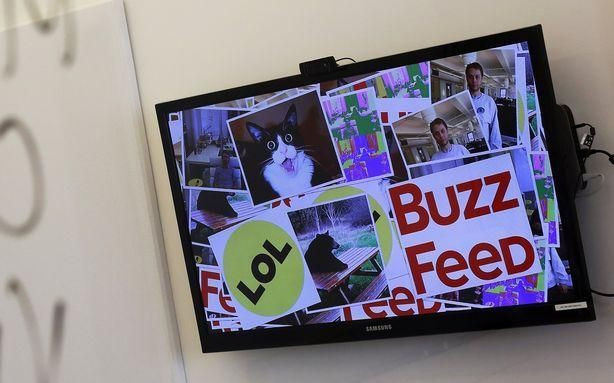20 Years Of Web Publishing: Former HotWired And Pathfinder Execs Look Back On 1994

In early 1994, when most people were busy listening to Green Day or watching “Beavis and Butt-Head,” two forward-thinking media professionals attended a magazine launch party at the Waldorf Astoria hotel in New York, where they struck up a conversation about the future of publishing. Walter Isaacson, then an editor at Time Inc., and Louis Rossetto, founder and publisher of Wired magazine, discovered they had the same problem. They were putting content from their magazines on the Internet, but they were tired of being at the mercy of online services like AOL and CompuServe, which provided the publishing platforms but also reaped the monetary benefits.
It was a hostage situation, at best, and both Isaacson and Rossetto wanted more control. They knew it was time to develop their own “electronic networks.” But how?
“We wanted to get out of the grips of the proprietary online services,” Isaacson recalled in a recent phone interview with International Business Times. “So Louis and I talked about, if we went on the Internet, how should we do it? And we both agreed to do the Web.”
That October, two of the Web’s earliest commercial ventures launched into existence: Pathfinder, a portal for Time Inc.’s online content, and HotWired, an online companion to Wired magazine. As Isaacson recalled, “We both came online within the same week.”
The Internet, and publishing, would never be the same.
It’s been 20 years since Pathfinder and HotWired dragged the media industry -- sometimes kicking and screaming -- into the 21st century. As 2014 comes to a close, it’s worth looking back at two tumultuous decades of Web publishing -- what worked, what didn’t and what lessons today’s digital publishers can learn from those early ventures, which were as financially precarious as they were innovative.

It’s hard to imagine now, but in 1994, even being on the Web wasn’t a foregone conclusion. At that time, the Internet was a Wild West of competing protocols -- Gopher, FTTP and others -- and the then-nascent World Wide Web was just one option.
“The Internet was just a thing,” said Andrew Anker, HotWired’s co-founder and former chief executive. “You had a bunch of different ways you could interact with it.”
But the Web, a system of linked hypertext documents, enjoyed a key advantage with the 1993 launch of the NCSA Mosaic, an early Web browser developed at the University of Illinois. The browser not only made it easier for non-techies to navigate the Internet, its graphical interface was perfect for translating magazine-style content to the digital world.
“As soon as we saw the Web, and all the things it could do, we knew that was going to be it,” recalled Julie Chiron, a former HotWired editor who was part of the team that launched it.
Show them the money
Pathfinder and HotWired may have launched around the same time, but they weren’t on the same playing field. The former, proposed by Isaacson in March 1994, had the financial backing of Time Warner, one of the world’s largest media conglomerates. But that cushion, Isaacson admits, didn’t always lead to the most innovative thinking about what the Web could be.
“We put old wine into new bottles,” Isaacson said of the Web’s early days. “We just dumped the magazine online instead of creating communities. That was one of the philosophical disputes at the beginning of the era of putting ourselves on the Web.”
The folks at HotWired, meanwhile, didn’t have the luxury of philosophical debates. Their parent company, Wired Ventures, was barely a year old, and the small team tasked with creating its new online presence knew it had to make money, and fast.
“From the get-go, there was an attempt to figure out how to translate the advertising model to the Web,” said Chiron, who was trained in print media and said working for HotWired “felt risky” at a time when many of her peers were carving out careers at traditional newspapers or magazines.
“Wired magazine itself was a startup,” added Anker, who helped create HotWired’s original business plan. “As a startup, it’s like -- it has to be a business. So my big insight into the process was, ‘God, all the stuff that works on the print side -- in advertising -- can be translated to the online side.'”
Thus marked the birth of the ad-supported Web, an ecosphere that continues to this day and has enabled the creation of Silicon Valley giants like Google Inc. and Facebook Inc. In a way, you can thank -- or blame -- HotWired for the Internet that we know and love. HotWired has been credited with running the world’s first banner ads. (As Internet lore tells it, the very first banner was an ad for AT&T asking, “Have you ever clicked your mouse right here? You will.”) At that time, most advertisers didn’t even have their own websites, so the early ads would click through to microsites set up by ad agencies.
For a while it all worked swimmingly. Advertisers loved the new metrics and interactivity that Web ads provided; they loved being able to know, for the first time in history, how many people were actually looking at their ads. A digital gold rush followed and, as Isaacson recalled it, “People from Madison Avenue came over with bags of cash.”
But the good times didn’t last. By the end of the dotcom bubble in 2000, HotWired had been gobbled up by the search engine company Lycos, and Pathfinder had been phased out, deemed an expensive flop by Time Warner.

Old ideas, new spin
For people outside of media, it can be hard to explain why the high profit margins of print’s golden age didn’t follow the transition to digital. Ad-supported newspapers and magazines were highly profitable, so why not ad-supported websites?
Isaacson crystallizes the mathematics perfectly, calling it the law of simple supply and demand. Consider that in 1994, there were only about 2,700 websites, according to Internet Live Stats. Within a year, that number skyrocketed to 23,500, and by 1997 it was over 1 million. Once advertising space becomes unlimited, the amount of money publishers can charge for that space -- known as costs-per-thousand impressions, or CPMs -- becomes diminished.
“We could watch it happening,” Isaacson said. “The number of possible avails for advertisers goes up exponentially, but the amount of advertising dollars is relatively flat -- there’s only a limited number of cars Chevrolet is going to introduce, et cetera. So when the avails are going up exponentially, and the advertiser revenue is staying flat, at a certain point the CPMs collapse, as they did.”
Today many of the biggest players in digital media have moved away from the display ad-based model of the 1990s. Social-focused brands like Vox Media and BuzzFeed Inc. have won the hearts of advertisers and venture capitalists, in part, with diversified business models that include video production and native advertising divisions.
But to some extent this is putting new clothes on an old idea: so-called native ads that look, feel, behave and -- ideally -- spread like good content. Legacy media companies like The New York Times Co. are investing heavily in sponsored content divisions as well, despite concerns that such techniques threaten to dissolve the traditional wall of separation between journalism and advertising.

It’s certainly a new golden age of media startups, but will it last? Isaacson isn’t so sure. “What that does is dig yourself out of a hole by making the hole deeper,” he said of sponsored content. “Once you do that, everybody else can start doing native and sponsored, so the CPMs for that will collapse -- and you will have prosecuted yourself.”
If Isaacson sounds cynical about digital advertising, he’s no cynic when it comes to the technology behind it. His latest book, “The Innovators,” chronicles the digital revolution and the people who made it happen. At the same time, he’s surprisingly forthcoming about the mistakes publishers made in the Web’s infancy, and some of the paradoxes that online publishing presented. He speaks of the “original sin” of putting content online for free, but admits it probably couldn’t have happened any other way.
“There’s a certain American logical fallacy that says, ‘There’s a solution to every problem,'” he said. “It may be that there was no way could’ve charged anything for going online, and yet there’s no way we could’ve made it sustainable with advertising.”
Today the healthiest media companies cling to subscription models, which is why the TV industry clings to its “bundle,” a package of channels it sells through cable providers. Outside a bundle, media must prove it is indispensable to the consumer each billing cycle; in a world of proliferating free options, this is increasingly difficult to do.
HotWired’s Anker said it’s easy to look back with hindsight and question what went wrong about the early days of Web publishing, but he prefers to look forward. Twenty years ago, the Web as a commercial venture had barely been explored. Today Anker runs a company called Tugboat Yards, which creates tools that help online publishers monetize their audiences, and he said any workable strategy for digital publishers will likely include a combination of ad and subscriber revenue.
In 1994, that wasn’t even an option. “Even if we wanted to launch with user-pay, you literally couldn’t even take a credit card at that point,” Anker said. “So it was sort of impossible.”
Christopher Zara is a senior writer who covers media and culture. Got a news tip? Email me here. Follow me on Twitter @christopherzara.
© Copyright IBTimes 2025. All rights reserved.





















